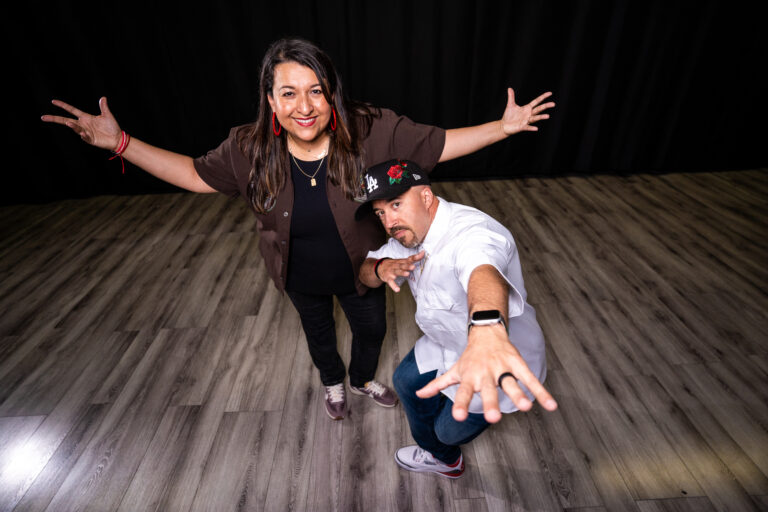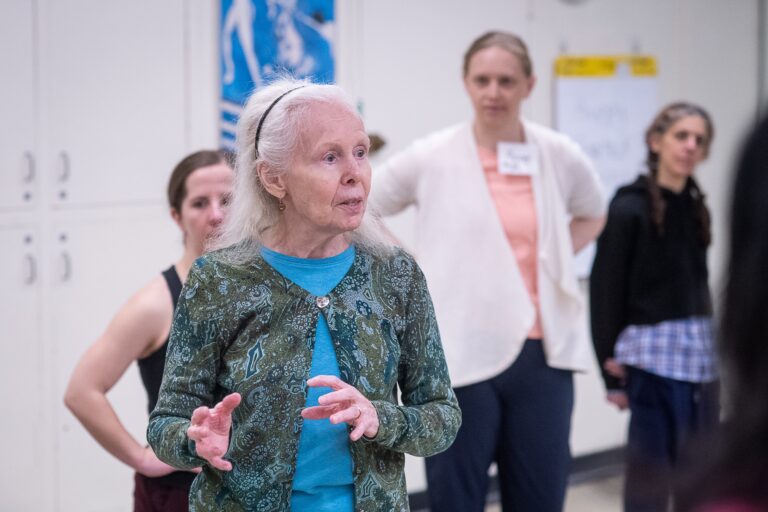Gottfried Arnold in action at DEL
“I’m looking for the big idea,” says Jody Gottfried Arnhold on a recent Friday afternoon at the 92nd Street Y. Trim and petite in a zip-up track jacket, black athletic pants and sneakers, Arnhold looks ready to chase this big idea down Lexington Avenue if that’s what it takes. “There are 1,500 schools in New York City and more every day. There are close to a million and a half kids in the school system, and less than 200 certified dance educators. It’s just not enough.”
Arnhold is the founding director of the Y’s Dance Education Laboratory (DEL), which has been training and supporting teachers since 1995. DEL’s approach is modeled on Arnhold’s own pedagogical practices, honed over nearly 25 years spent teaching dance in the New York City public school system and mentoring others who wanted to do the same.
Today, thanks in large part to Arnhold’s tireless work through DEL and the New York City Department of Education (DOE), more and more certified teachers are flowing into the school system fortified with the knowledge and practical skills to build stellar dance programs.
But, as Arnhold says, it’s not enough. Her goal is to offer high-quality, sequential dance education to every child in the public school system—but to reach it, she needs that big idea. Her friends and colleagues have no doubt she’ll make it happen.
“The great inspiration about working with Jody is that she will never give up the dream,” says Joan Finkelstein, who has worked closely with Arnhold for many years, first as director of the Y’s Harkness Dance Center and currently as director of dance programs in the DOE’s Office of Arts and Special Projects. “It gives people energy to be around that kind of idealistic persistence—and it’s more than idealism, because she’s also very practical. She truly believes that if we all band together this can happen. She’s brilliant, she’s dedicated and she’s unstoppable.”
A Grassroots Effort
Name a dance-related initiative and chances are Arnhold is involved in it, from co-chairing the committee to draft the New York City Department of Education Curriculum Blueprint for Teaching & Learning in Dance to chairing the board of Ballet Hispanico. She advocates on behalf of dance education to “everybody who will listen.”
“I think that every child deserves an arts education, and I’d like to see that dance is first,” Arnhold says. “Imagine what the culture would be if we raise generations of dance-literate children. We would encourage young people’s artistry and also their creativity and humanity. We would bring life and energy into their schools.”
Arnhold wants to put a certified dance teacher in every public school, and she emphasizes that dance education must start when children are young in order for it to properly take root. It’s an ambitious goal, to be sure. But for Arnhold, the value is multidimensional—she sees it as fundamental not only to children’s development and learning but to the survival of the dance field as a whole.
“It’s a grassroots effort for our art,” says Arnhold, who was honored with the National Dance Education Organization’s Visionary Award in 2009. “I’m involved in many dance companies, and I think that their interest has to be dance education, otherwise there’s not going to be anybody coming to see them. If we could raise dance-literate children, we would have an audience for dance. We’d also have more performers because the talent is going to be uncovered.”
Early Influences
A few powerful experiences and key people helped shape Arnhold’s vision, the first being her own dance training, as a child, with Erika Thimey in Washington, DC.
“Her influence on me was huge,” Arnhold says of Thimey, who trained with Mary Wigman in her native Germany. “Dancemaking was part of every class, where we talked about the dances we created, performed for each other and made dances based on stories and ideas. It was this very rich, deep experience that I loved.”
Still, when Arnhold headed to New York City after graduating from the University of Wisconsin, Madison, she had no plans to teach—it was a performing career she wanted. But she quickly realized it wasn’t to be. “I needed real structure in my life, and I recognized that,” she says. “I was a teacher at heart.”
Fortuitously, the city happened to be in need of teachers at the time and was recruiting young talent through the Intensive Teacher Training Program. Arnhold enrolled at New York University in the summer of 1967, and 12 credits later she was plunged into her first teaching experience, in a first-grade classroom. “I loved it,” she says.
But she missed dance. Arnhold earned a master’s degree in dance education from Columbia University’s Teachers College and soon after landed a job as a dance teacher at P.S. 75 on Manhattan’s Upper West Side. “That was in the ’70s when the arts had been decimated,” she says. “But I found a principal who was excited about the idea of having the arts in his school, and he really wanted dance.”
Perhaps more importantly, Arnhold found Joan Sax, a fellow teacher at P.S. 75 who had just returned from a year of study at the Laban school in England. “It was through Joan Sax that I came to appreciate the application of Laban Movement Analysis to teaching dance to children,” she says. “The Laban material has guiding principles that apply to teaching process rather than product, the idea that everybody’s movement is valued and everyone can express themselves through movement.”
As Arnhold’s program came together, dance became central to life at P.S. 75. If there was an event, Arnhold and her students created a dance for it—whether it was a dedication ceremony for a new playground, a change of season, a math unit in symmetry and asymmetry or the death of a teacher. She knew she had something special on her hands, and she wanted to find a way to replicate it in other schools.
“Dance became the heart and soul of that school,” she says. “I was always thinking, ‘How can this happen someplace else?’”
Arnhold mentored the student teachers who flocked to her classroom each year, and eventually she began sharing her practices with other schools through a grant from Teachers Network. By 1991, she had left P.S. 75 and was focusing her efforts on teacher education. A few years later, DEL was born.
Bringing It All Together
With DEL, all of Arnhold’s experiences, feelings and ideas about dance education have coalesced into a fully formed whole. “Jody is the heart and soul of the program,” says John-Mario Sevilla, who joined DEL as administrator in 2007. “It’s very much an embodiment of her vision.”
Arnhold continues to teach DEL’s Foundations of Dance Education course, and many of her protégés have taught alongside her, among them early childhood dance educator Ann Biddle and Barbara Bashaw, coordinator of dance education and teacher certification at Rutgers University. “We are all bringing something special to it,” says Tina Curran, director of the Language of Dance Center. “Her vision for providing quality dance education is so big that there’s room for it to come about in many different ways. And I think that’s what attracts people with a diversity of expertise to work together.”
In addition to her work at DEL, Arnhold partners with Finkelstein at the DOE on a variety of projects aimed at recruiting and supporting certified dance teachers. “She recently initiated a grant to the Fund for Public Schools supporting programs for new dance teachers,” Finkelstein says, adding that the grant includes mentoring, a stipend for each first year dance teacher’s school, a toolkit of instructional resources and a discount on DEL courses.
Another recent initiative is the Arnhold Dance Fellows program, which identifies current teaching fellows with an undergraduate dance degree and helps them add a dance license to whatever teaching certification they are pursuing. Arnhold is also chair of the Hunter College Dance Education Advisory Committee, working with college President Jennifer Raab on plans to launch three new graduate dance education programs.
“All of these good things are happening, but there is still much work to do,” Arnhold says. “We still need the big idea. Training for more prepared, certified, inspired dance
teachers is critical. More dance and cultural organizations must make education of our children a top priority. Most important, we need more principals and schools to provide fertile ground for all the arts—dance especially—so that all children have access. We all have to join together to make this happen.” DT
Michelle Vellucci holds a master’s in dance and education from the University at Buffalo. She writes about dance and the arts in NYC.
Click here to watch exerpts of the Foundations of Dance Education course, part of the DEL Program.
About 92nd St. Y’s Dance Education Laboratory
Jody Arnhold was a classroom teacher in the early 1970s when she was asked to start school-based dance programs. There was little to guide her. Fast-forward 25 years. In 1993 Joan Finkelstein, director of Dance Programs for the New York City Department of Education, was the newly appointed director of the Harkness Dance Center. To help re-establish the innovative role the Dance Center had played under founder William Kolodney, director from 1936 to 1969, Finkelstein asked Arnhold what contribution the Center could make to dance education. Arnhold suggested teacher training.
From that seed has grown the Harkness Dance Center’s Dance Education Laboratory, which offers intensives, weekend workshops and ongoing coursework. Since 1994 when Arnhold and Ann Biddle taught the first one-day workshop, more than 2,800 dancers have participated in DEL courses.
“We are committed to the premise that every child should have an in-school dance experience,” says Director John-Mario Sevilla. “We think of dance as connected to other subjects; as a way of thinking and communicating fundamental to articulating who you are in body, mind and spirit; to understanding space and time; to knowing who you are as part of a community. It’s holistic.”
The DEL approach is built on Laban Movement Analysis, a language and system of notation developed by Rudolf Laban. In addition to
guiding unit and lesson planning, the vocabulary provides a mode of clear communication with classroom teachers.
DEL now provides professional development for the New York City Department of Education and college credit is available through SUNY Empire State College. In addition to approaches to technique, improvisation and composition, participants study classroom management, conflict resolution, dance history, dance anatomy, biomechanics and health.
“We’re giving people tools for creating lesson plans, a process that can be as fulfilling as creating a piece of choreography,” says Arnhold. “The lesson plan is a beautiful arc starting with warm-up, development, elaboration, culmination and cool-down. I want each person to understand this methodology and take it to where they will come out with a personal voice.” —Carrie Stern
Photo by Rachel Papo



